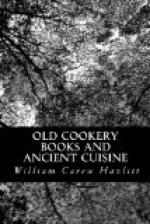“Item, that no tavern-keeper or inn-keeper shall keep any cook shop upon pain to forfeit and pay for every time offending therein 4d.”
The London cooks became famous, and were not only in demand in the City and its immediate outskirts, but were put into requisition when any grand entertainment was given in the country. In the list of expenses incurred at the reception of Queen Elizabeth in 1577 by Lord Keeper Bacon at Gorhambury, is an item of L12 as wages to the cooks of London. An accredited anecdote makes Bacon’s father inimical to too lavish an outlay in the kitchen; but a far more profuse housekeeper might have been puzzled to dispense with special help, where the consumption of viands and the consequent culinary labour and skill required, were so unusually great.
In the Prologue to the “Canterbury Tales,” the Cook of London and his qualifications are thus emblazoned:—
“A Cook thei hadde with hem for
the nones,
To boylle chyknes, with the mary bones,
And poudre marchaunt tart, and galyngale;
Wel cowde he knowe a draugte of London
ale.
He cowde roste, and sethe, and broille,
and frie
Maken mortreux, and wel bake a pie.
But gret harm was it, as it thoughte me,
That on his schyne a mormal had he:
For blankmanger that made he with the
beste.”
This description would be hardly worth quoting, if it were not for the source whence it comes, and the names which it presents in common with the “Form of Cury” and other ancient relics. Chaucer’s Cook was a personage of unusually wide experience, having, in his capacity as the keeper of an eating-house, to cater for so many customers of varying tastes and resources.
In the time of Elizabeth, the price at an ordinary for a dinner seems to have been sixpence. It subsequently rose to eightpence; and in the time of George I. the “Vade Mecum for Malt Worms (1720)” speaks of the landlord of The Bell, in Carter Lane, raising his tariff to tenpence. In comparison with the cost of a similar meal at present, all these quotations strike one as high, when the different value of money is considered. But in 1720, at all events, the customer ate at his own discretion.
Their vicinity to East Cheap, the great centre of early taverns and cook’s-shops, obtained for Pudding Lane and Pie Corner those savoury designations.
Paris, like London, had its cook’s-shops, where you might eat your dinner on the premises, or have it brought to your lodging in a covered dish by a porte-chape. In the old prints of French kitchen interiors, the cook’s inseparable companion is his ladle, which he used for stirring and serving, and occasionally for dealing a refractory garcon de cuisine a rap on the head.
The Dictionary of Johannes de Garlandia (early thirteenth century) represents the cooks at Paris as imposing on the ignorant and inexperienced badly cooked or even tainted meat, which injured their health. These “coquinarii” stood, perhaps, in the same relation to those times as our keepers of restaurants.




